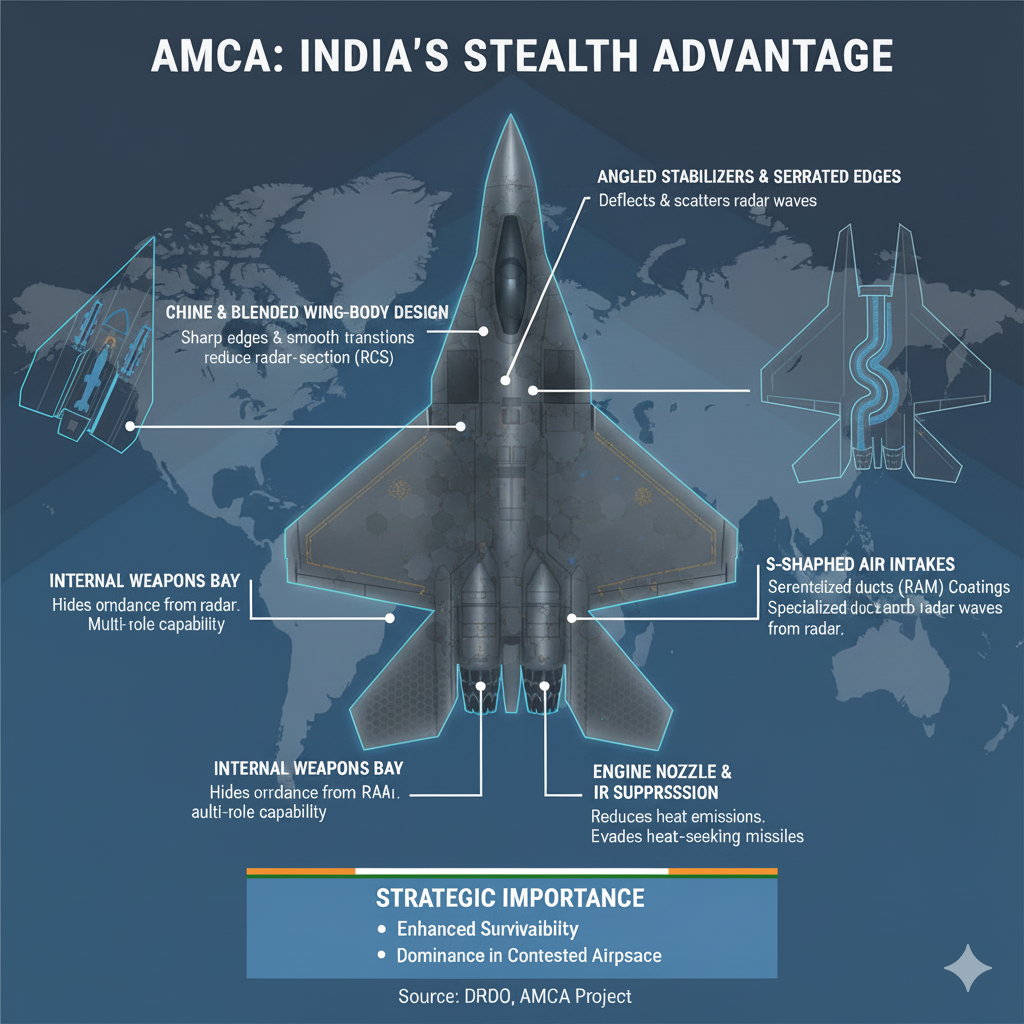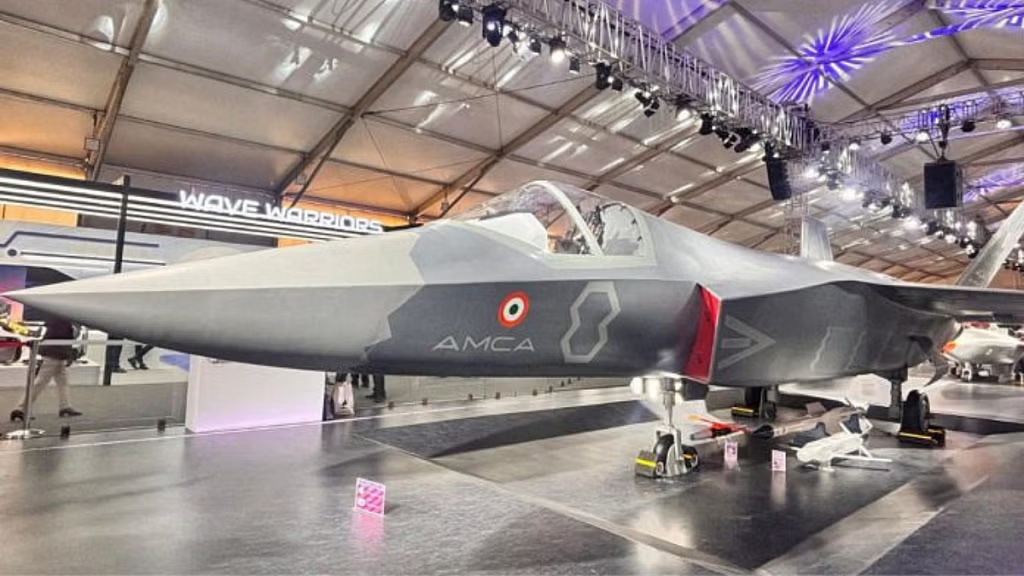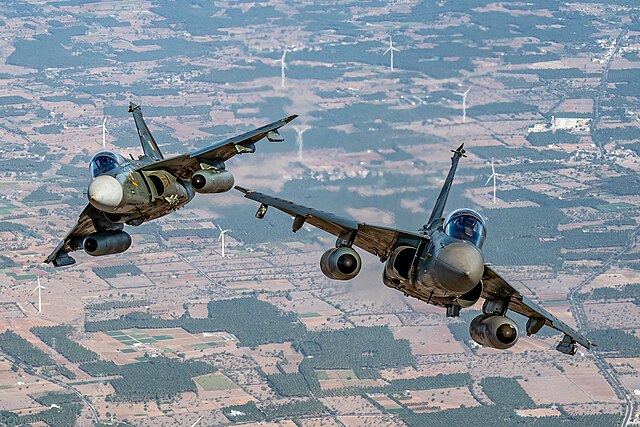AMCA: India’s 5th Generation Fighter – The Complete Guide
A definitive, consolidated guide to the Advanced Medium Combat Aircraft (AMCA) — its design, stealth, engines, avionics, weapons, industry dynamics, timelines and the road ahead for India’s fifth-generation ambitions.

Program overview
The Advanced Medium Combat Aircraft (AMCA) is India’s project to field a domestically designed fifth-generation multirole stealth fighter. Led by the Aeronautical Development Agency (ADA) and with HAL as the prime production partner, AMCA is central to India’s push for defence self-reliance under the Atmanirbhar Bharat vision.
For the deep technical background and initial program brief, see our primary overview: AMCA: India’s 5th Generation Fighter Jet Program.
Stealth & airframe design
Stealth forms the core of any fifth-generation fighter. AMCA’s low-observable approach covers three linked areas: shaping (airframe geometry to deflect radar), materials (composites and RAM), and signature management (infrared and acoustic reduction).
Shaping & aerodynamics
AMCA uses blended fuselage surfaces, internal weapons bays and canted empennage to minimize radar cross-section (RCS). The airframe geometry balances stealth with aerodynamic efficiency to retain dogfight and high-alpha handling characteristics.
Materials & construction
Extensive composites and locally developed radar absorbing materials (RAM) are planned for primary structures. Indigenous material maturity remains a programme-critical item — both for performance and maintainability across service cycles.
IR & exhaust signature management
Jet nozzle design, exhaust mixing techniques and careful intake shaping reduce infrared signature—vital to defeat modern IRST (infrared search & track) sensors.
Dive deeper: AMCA Stealth Technology.
Engine development — the powerhouse
Engines determine payload, range, climb rate and whether the aircraft can supercruise (sustain supersonic speed without afterburner). India is pursuing a two-track approach:
- Interim (Mk-1): Use mature foreign engines (GE F414 class) to flight-test prototypes and reach early capability.
- Indigenous (Mk-2): Develop a high-thrust, low-maintenance engine in partnership with global OEMs — a 110–125 kN class powerplant for final operational variants.
Achieving supercruise and high reliability requires focused R&D on turbine materials, cooling systems, and FADEC (Full Authority Digital Engine Control). For more details, see: AMCA Engine Development.
Performance goals
- Thrust-to-weight ratio > 1 for sustained agility.
- Supercruise at Mach 1.5+ without afterburner.
- High fuel efficiency for extended range.
- Advanced health monitoring and digital control for maintainability.
Avionics & sensors — the fighter’s brain
Avionics transform raw sensor data into actionable battlefield awareness. AMCA is designed as a multi-sensor, networked platform where sensor fusion is the force multiplier.
AESA radar
An Active Electronically Scanned Array (AESA) radar provides rapid target updates, LPI (low probability of intercept) modes, and multi-target tracking. India’s indigenous efforts, like the Uttam AESA radar, reduce reliance on foreign imports and allow full software control for upgrades.
Electronic Warfare & Sensor Suite
AMCA integrates electronic warfare systems, advanced IRST (infrared search & track), and distributed aperture systems. Together, these allow threat detection, missile warning, and targeting at longer ranges, while minimizing AMCA’s own signatures.
Network-centric operations
With India’s push for networked warfare, AMCA will link with airborne early warning (AEW) platforms, drones, and other fighters for cooperative engagement. This transforms a single aircraft into a force multiplier across a theatre.
Related read: AMCA Stealth & Sensor Integration.
Weapons & payload
AMCA will carry a mix of air-to-air, air-to-ground, and precision-guided weapons. Internal weapons bays maintain stealth while external pylons may be used in low-threat scenarios.
Internal payloads
- Air-to-air missiles (AAMs) for BVR (beyond visual range) combat.
- Precision-guided bombs and standoff munitions.
- Advanced electronic countermeasure pods and reconnaissance equipment.
External pylons
For high-intensity conflicts, AMCA can carry external stores on hardpoints, but this reduces stealth signature. Modular pylon design allows flexibility between stealth and payload.
For related details, see: AMCA Weapons & Payload Developments.
Industry & institutional dynamics
AMCA involves multiple Indian and international partners. HAL leads production, ADA leads design, while DRDO labs contribute materials, avionics, and engines. Coordination between government, private sector, and R&D institutions is crucial.
Note: Internal debates between HAL, LT, and BEL over engine integration and avionics highlight the challenge of large-scale defence collaboration in India. AMCA’s progress reflects both ambition and the need for effective program management.
See also: The AMCA Showdown.
Timelines & challenges
- Prototype development: Expected in the mid-2020s.
- Flight testing: Early Mk-1 prototypes to validate aerodynamics and engines.
- Operational entry: Mk-2 variants likely in the 2030s.
Key challenges include engine maturity, stealth materials, avionics software integration, and keeping costs under control. AMCA’s timeline is ambitious, but if executed well, it will redefine India’s air combat capabilities.
Conclusion
The AMCA program represents a leap in India’s indigenous fighter development, combining stealth, advanced avionics, indigenous engines, and weapons systems. It is a litmus test for India’s defence industrial base and project management capabilities. Success will position India as a global fifth-generation fighter contender and a symbol of technological self-reliance.
Stay tuned for more updates on AMCA developments and breakthroughs in India’s fifth-generation fighter program.



Pingback: HAL’s Next-Gen Unmanned Wingman Drone Program for AMCA Integration - DefenceNiti.com